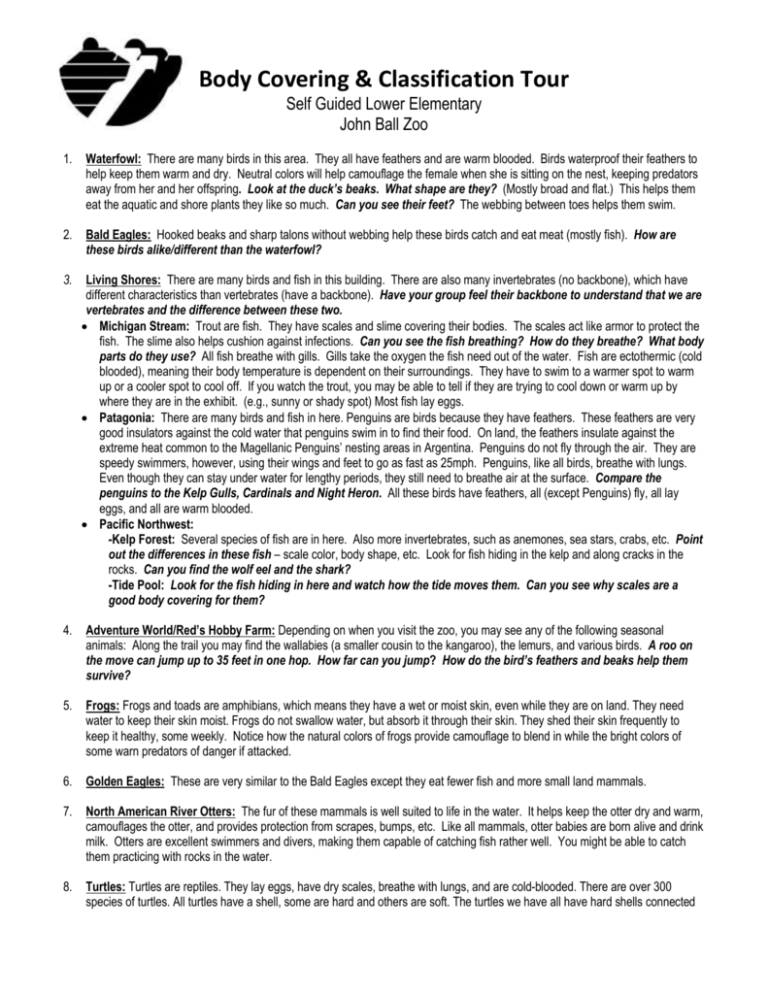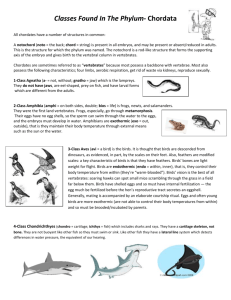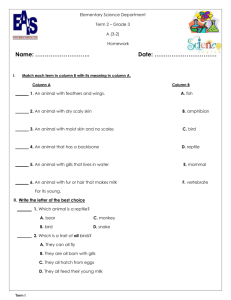Body Coverings and Classification Tour for lower
advertisement

Body Covering & Classification Tour Self Guided Lower Elementary John Ball Zoo 1. Waterfowl: There are many birds in this area. They all have feathers and are warm blooded. Birds waterproof their feathers to help keep them warm and dry. Neutral colors will help camouflage the female when she is sitting on the nest, keeping predators away from her and her offspring. Look at the duck’s beaks. What shape are they? (Mostly broad and flat.) This helps them eat the aquatic and shore plants they like so much. Can you see their feet? The webbing between toes helps them swim. 2. Bald Eagles: Hooked beaks and sharp talons without webbing help these birds catch and eat meat (mostly fish). How are these birds alike/different than the waterfowl? 3. Living Shores: There are many birds and fish in this building. There are also many invertebrates (no backbone), which have different characteristics than vertebrates (have a backbone). Have your group feel their backbone to understand that we are vertebrates and the difference between these two. Michigan Stream: Trout are fish. They have scales and slime covering their bodies. The scales act like armor to protect the fish. The slime also helps cushion against infections. Can you see the fish breathing? How do they breathe? What body parts do they use? All fish breathe with gills. Gills take the oxygen the fish need out of the water. Fish are ectothermic (cold blooded), meaning their body temperature is dependent on their surroundings. They have to swim to a warmer spot to warm up or a cooler spot to cool off. If you watch the trout, you may be able to tell if they are trying to cool down or warm up by where they are in the exhibit. (e.g., sunny or shady spot) Most fish lay eggs. Patagonia: There are many birds and fish in here. Penguins are birds because they have feathers. These feathers are very good insulators against the cold water that penguins swim in to find their food. On land, the feathers insulate against the extreme heat common to the Magellanic Penguins’ nesting areas in Argentina. Penguins do not fly through the air. They are speedy swimmers, however, using their wings and feet to go as fast as 25mph. Penguins, like all birds, breathe with lungs. Even though they can stay under water for lengthy periods, they still need to breathe air at the surface. Compare the penguins to the Kelp Gulls, Cardinals and Night Heron. All these birds have feathers, all (except Penguins) fly, all lay eggs, and all are warm blooded. Pacific Northwest: -Kelp Forest: Several species of fish are in here. Also more invertebrates, such as anemones, sea stars, crabs, etc. Point out the differences in these fish – scale color, body shape, etc. Look for fish hiding in the kelp and along cracks in the rocks. Can you find the wolf eel and the shark? -Tide Pool: Look for the fish hiding in here and watch how the tide moves them. Can you see why scales are a good body covering for them? 4. Adventure World/Red’s Hobby Farm: Depending on when you visit the zoo, you may see any of the following seasonal animals: Along the trail you may find the wallabies (a smaller cousin to the kangaroo), the lemurs, and various birds. A roo on the move can jump up to 35 feet in one hop. How far can you jump? How do the bird’s feathers and beaks help them survive? 5. Frogs: Frogs and toads are amphibians, which means they have a wet or moist skin, even while they are on land. They need water to keep their skin moist. Frogs do not swallow water, but absorb it through their skin. They shed their skin frequently to keep it healthy, some weekly. Notice how the natural colors of frogs provide camouflage to blend in while the bright colors of some warn predators of danger if attacked. 6. Golden Eagles: These are very similar to the Bald Eagles except they eat fewer fish and more small land mammals. 7. North American River Otters: The fur of these mammals is well suited to life in the water. It helps keep the otter dry and warm, camouflages the otter, and provides protection from scrapes, bumps, etc. Like all mammals, otter babies are born alive and drink milk. Otters are excellent swimmers and divers, making them capable of catching fish rather well. You might be able to catch them practicing with rocks in the water. 8. Turtles: Turtles are reptiles. They lay eggs, have dry scales, breathe with lungs, and are cold-blooded. There are over 300 species of turtles. All turtles have a shell, some are hard and others are soft. The turtles we have all have hard shells connected to their backbone. The hard shells protect the turtle from predators. Feel the two different turtle shells on display. Why is one flat and one more dome like? 9. Bobcat: Bobcats are warm blooded mammals. They are cousins to the lynx and mountain lion. They are one of a handful of cats at the zoo. The pattern of their fur helps them blend in with their surroundings and sneak up on their prey as they hunt them at night. Although some maps don’t show them in Michigan, they can be found throughout the state. Check out their range map on the sign for yourself. 10. Brown Bears: The bears are mammals. Brown Bears are found primarily in Alaska and are bigger in size due to their high protein (fish) diet. Grizzly Bears get the name not from their fierceness, but from the grizzled (or white/gray) appearance of fur around their face and head as they get older. Grizzly Bears live in the northern part of North America where it can be quite cold. Thick fur provides insulation against the cold. Look at the claws they use as great digging tools. 11. Mountain Lions/Snow Leopards: These similar mammals (although found in different areas in the world) are kept extremely warm with their fur, which also helps them to camouflage. These large cats are excellent jumpers which helps them hunt their prey. See how high they can jump. Now see how high you can jump! 12. South American Exhibit: Depending on when you visit the zoo, you may see any of the following seasonal animals: -Crested Screamer: Their feathers help them stay warm and cool, provide camouflage, and are essential for flight. -Maned Wolves: These shy and secretive mammals have very long legs to help them see over the tall grass in their native habitats. -Tapir: The fur on Tapirs is short and can range in a variety of colors from reddish-brown to grey, and even black. Young Tapirs have stripes and spots on their fur to blend into their habitat. -Capybara: These mammals are the largest-known rodent. -Monarch Butterflies: The butterfly’s life cycle includes egg, caterpillar, chrysalis, and butterfly. They migrate from their birthplace to Mexico and back each year. You can help Monarch butterflies in your yard by planting milkweed, the plant they need to lay their eggs on and the only food the caterpillars eat! 13. African Wildlife: Depending on when you visit the zoo, you may see any of the following seasonal animals: Bongos, Warthog, White-backed Turkey Vultures, Egyptian Goose, and Guinea Baboons. -Lions: These large predators eat meat, which makes them carnivores. The females hunt for food for the entire pride (group of lions), while the male lions actually eat first. Lions can sleep up to 20 hours per day. -Warthogs: do not have much fur or hair, but they wallow in mud to cool off their skin and to protect it from the sun and insects. -Bongos: These animals have striped fur that helps them camouflage in the wilderness. -Vultures: These birds do not have many feathers on their heads since they eat dead animals; it helps to keep their heads clean even while feeding deep into the bodies of dead animals. 14. Chimpanzees: Chimpanzees are mammals. They are born live, are warm-blooded, breathe air, and have hair for body covering. The young nurse or drink milk from their mothers. Chimps belong to the class Primates. They are not monkeys, because monkeys have tails. Chimps are considered apes, which do not have tails. Chimps will groom themselves and each other. This is a way of communication. They have opposable thumbs to help them climb. They are considered to be very strong. Find the primate handprints. Does the chimp print look like one you may know? 15. Treasures of the Tropics Building: The animals in the first part of the building are active at night and sleep during the day. Most of these animals live in Central America where it can be warm and moist. While here, look at the different animals and ask yourself, what type of animal is it and what is its body covering? Further into this building, you will find many reptiles, amphibians, and mammals. This building tends to be quite warm because most of the animals here are ectothermic (cold blooded). Their body temperature is dependent on their surroundings. Reptiles have dry, scaly skin, lay eggs which are leathery, breathe air, and are cold blooded or ectothermic. There are many different species of snakes here and they all have dry scales covering their bodies. The bright colors help them hide in a variety of places. Turtles have dry scales covering their shells, head, legs, and necks. Lizards also are reptiles with dry scales. Amphibians are covered with moist or wet skin whether or not they are in the water or on dry land. They breathe with gills when they are young and then grow lungs and breathe air. They lay jelly-like eggs, and are cold blooded. Mammals are animals covered in fur. They are warm blooded, breathe with lungs, have live birth, and the mothers nurse their young with milk. ZOO TOUR ACTIVITY Body Covering Tour Check off each animal when you see it in the Zoo. What is its body covering? Draw an animal you find at the zoo with each of the following body coverings and draw a picture of it in the space below. FUR FEATHERS DRY SCALES SLIMY SKIN SLIMY SCALES ZOO TOUR ACTIVITY Classification Tour As you tour the zoo, look for these animals. When you find them, write their vertebrate class. F______________ R______________ A______________ B_______________ M_________________ Leader: This is a sample of the animals you might see in the zoo today. As the children find each one have them write the type of animal below its picture. Also, talk about what body coverings each one has. Answers: Fish, Reptile, Bird, Amphibian, Mammal ZOO TOUR ACTIVITY Classification Tour As you tour the zoo, look for these animals. When you find them, circle their vertebrate class. bird mammal fish amphibian reptile bird mammal fish amphibian reptile bird mammal fish amphibian reptile bird mammal fish amphibian reptile bird mammal fish amphibian reptile In the following boxes, draw/label an animal you see in the zoo from each classification. On the lines below, write one characteristic of each classification. MAMMAL BIRD AMPHIBIAN ____________________ ____________________ ____________________ _ ____________________ ____________________ ____________________ ____________________ ____________________ ____________________ __ REPTILE FISH ____________________ ____________________ ____________________ _ ____________________ ____________________ ____________________ ZOO TOUR ACTIVITY Scavenger Hunt Cats have fur and are mammals. Find four different cats in the zoo. Birds have feathers and MOST birds fly. Find the flightless bird in the zoo and draw/label it below. 1._______________________________ 2._______________________________ 3._______________________________ 4._______________________________ Amphibians have slimy skin. List two different amphibians you find in the zoo. _______________________________ 1._______________________________ Reptiles have dry scales and are cold blooded. Name four different types of reptiles you see at the zoo. 2._______________________________ 1._____________________________ Which primate is considered an ape, not a monkey? Draw a picture of this animal and list one fact about it below 2._____________________________ 3._____________________________ 4._____________________________ ____ In the aquarium find the following animals and check them off. FISH _______________________________ _______________________________ Write your favorite zoo animal below. ________________________________ SHARK SEA STAR








